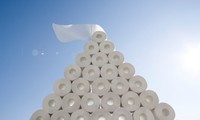The ick factor: Dutch project making bike lanes and bottles from used loo roll
Tjhe Guardian - A pilot scheme in the Netherlands is sifting sewage for cellulose, which it says can be recycled into valuable products.
 When you flush the toilet, you’re probably not thinking about bike lanes or home insulation. But that’s where your used loo roll could one day end up if a Dutch project to extract cellulose from sewage rolls out.
When you flush the toilet, you’re probably not thinking about bike lanes or home insulation. But that’s where your used loo roll could one day end up if a Dutch project to extract cellulose from sewage rolls out.
At the Geestmerambacht wastewater treatment plant near Alkmaar in the Netherlands, a two-year pilot project is using an industrial sieve to sift 400kg of cellulose, the natural fibres found in loo roll, from toilet sludge each day.
The cellulose, which would otherwise be incinerated at the end of the sewage treatment process, is cleaned and sterilised with very high temperatures and turned into a fluffy material or pellets. These are sold on as a raw material for products like asphalt and building materials.
A portion is also exported to the UK, where Brunel University is working on technology to transform it into an energy source, bioplastic bottles and other products.
The Dutch preference for luxury loo roll means the cellulose is of premium quality, says Carlijn Lahaye, managing director of CirTec, one of two companies behind the Cellvation project, which launched in June with help from an EU grant. “In the Netherlands, a lot of paper flushes through the toilet and it’s a high-quality fibre,” she says.
It’s one of several reasons Lahaye is convinced by the business case for recycling used loo paper. Although the quantities of cellulose processed by the pilot are currently too low to be profitable the basic model is sound, she says. “You remove something that costs energy to pump around, lower the operational cost, there’s more space to treat water and you get money for something that would be burnt as waste.”
The Dutch flush away 180,000 tonnes of paper each year, according to the country’s water authorities. And they are not alone in their profligacy: the European Tissue Symposium estimates that Europe used five million tonnes of toilet paper last year.
The cost – and opportunity – of this has long been clear to the Netherlands’ 25 water authorities, says Noor Ney, head of sanitation with the Hollands Noorderkwartier (HHNK) water board, which for eight years has been referring to treatment plants as “energy and resource factories”, she adds.
The Cellvation project is just one of many schemes around the country attempting to extract value from sewage, says Ney. Another company, AquaMinerals, works with various water providers to produce calcite pellets from wastewater, which can then be reused for softening water, or for products like ceramics and paint.
“[Sewage] isn’t only waste: it is a carrier of valuable resources: phosphates, cellulose, energy and clean water,” says Ney. “We act as a facilitator, allowing [a] company to see how far it gets on one of our plants. If it is able to extract a product that has value, then our process to clean water becomes cheaper.”


